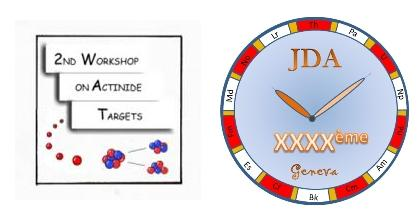Speaker
c degueldre
Description
White line of actinide x-ray absorption spectra as a tool for their atomic environment description
Claude Degueldre,1 Manuel Pouchon1, Goutam Kuri1, Camelia Borca2, Cedric Cozzo1
1 LNM – NES, Paul Scherrer Institute -5232 Villigen, Switzerland, e-mail: claude.degueldre@psi.ch
2 SYN Paul Scherrer Institute -5232 Villigen, Switzerland,,
From a recent plutonium uranium mixed oxide (MOX) fuel characterization campaign by micro-x-ray absorption fine structure (µ-XAFS) spectroscopy the chemical bounds, valences and stoichiometry of Pu and U were determined. Experimental data was gained for non-irradiated as well as for the irradiated (burn-up 60 MW d kg-1) fuel material examined in the center of the fuel as well as in its peripheral zone (rim). The MOX fuel undergoes locally crystalline changes during burn-up. In the fuel center, the slightly smaller burn-up (1700 dpa) compared to the fuel average limits damage and the rather high temperature (e.g. ~1675 K) allows healing. In the rim zone, the larger burn-up (2500 dpa) compared to average increases damage potential, however, the rather low temperature (e.g. ~875 K) reduces the healing action, which increases the defect occurrence and the partial disaggregation of the fuel. In the irradiated sample Pu remained Pu(IV)>95% and no (<5%) Pu(V) or Pu(VI) could be detected while the fuel could undergo slight oxidation in the rim zone. Any slight oxidation may be buffered by the UO2 matrix while locally fuel cladding interaction might also affect the redox of the fuel [1].
The white line factor ( ) may be defined from the characteristics of the near edge structure XANES feature as = 2 (IM - Im) / (IM + Im ) with IM the intensity of the white line and Im its intensity from the first minimum behind the white line. Its trend for Pu as a function of the coordination number (CN) is sketched in Fig 1. It is clearly observed that the white line decreases when Pu increases in valence state. This is due to the change of valence state as depicted in the structural pictures e.g. [O4AnO4]12- in AnO2(s) but also due to the formation of actinyl feature of [O=An=O]2+ and the potential of 5 oxygen atoms (e.g. water molecules) in equatorial plane.
The paper discusses also the impact of actinide Th, U, Np and Pu valence and atomic environment with regards to oxygen atoms from solution (hydrated ion) to gel (disordered) and to oxide (ordered) on the white line amplitude and morphology as recorded earlier [2].
This understanding is crucial since no significant edge energy shifts are generally recorded between Np(IV) and Np(V) or Pu(IV) and Pu(V). The discussion emphasises the use of XAFS for the characterization of actinides.
Fig. 1. Pu white line factor for Pu(III), Pu(IV), Pu(V) and Pu(VI)
in solution (sol) or gel or oxide (Ox).
References
[1] C. Degueldre et al., J. Nucl. Mater (2011) submitted.
[2] S. Conradson et al., J. Solid State Chem. 178, 521 (2005).




